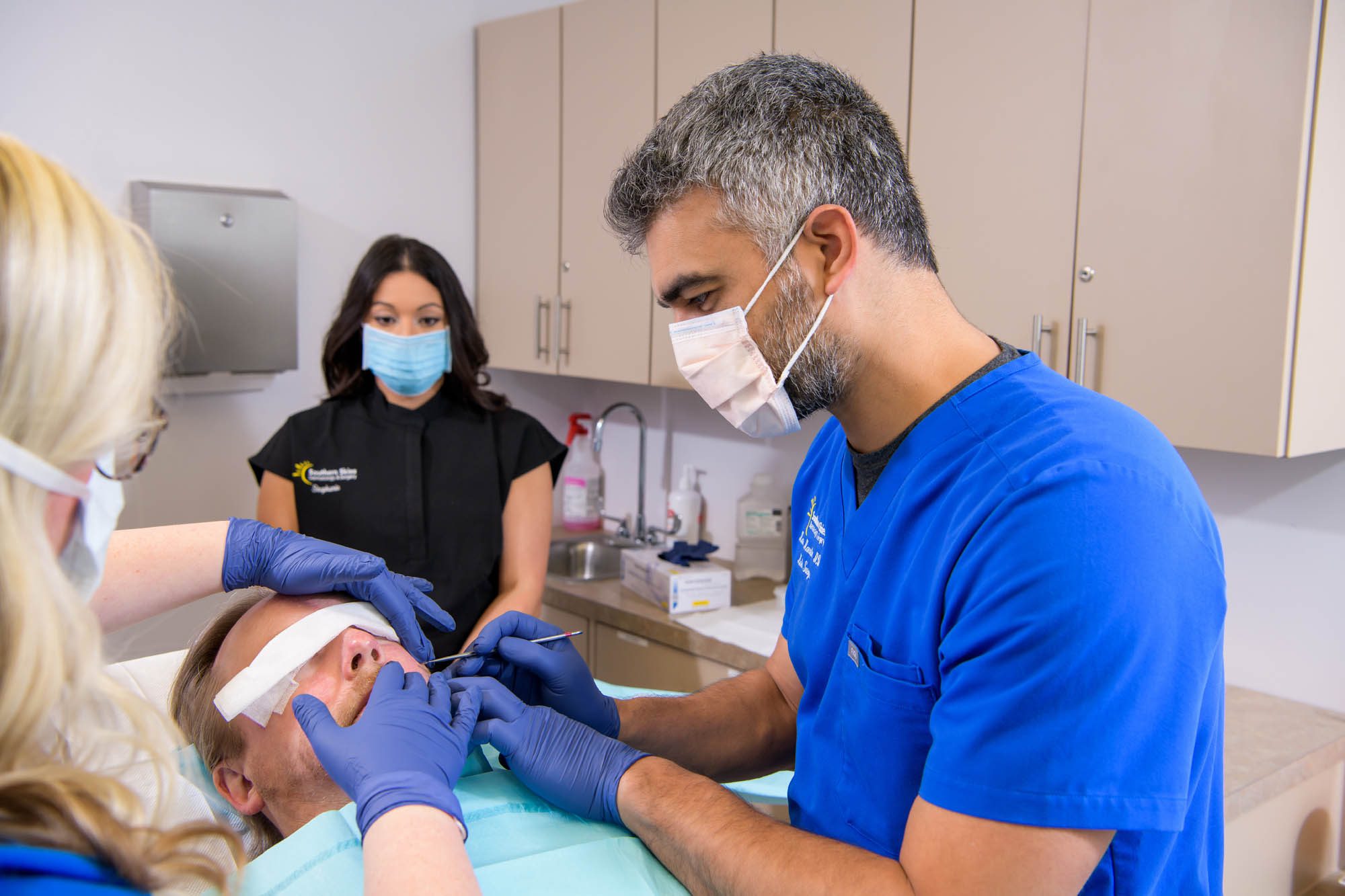Skin Biopsies
Birmingham’s Top Skin Biopsy Practice
A skin biopsy procedure is used by dermatologists to identify and diagnose various skin conditions, including skin cancer, benign (not dangerous) skin growths, and skin rashes. Performed under local anesthetic, the doctor takes a small sample which is sent for examination under a microscope by a pathologist. Patients are notified of the biopsy result as soon as they are available, which is typically 2-7 days.
-
 There are over 3,200 different skin diseases, and it’s necessary to examine your affected skin under a microscope to correctly diagnose your condition. This is done with a skin biopsy.
There are over 3,200 different skin diseases, and it’s necessary to examine your affected skin under a microscope to correctly diagnose your condition. This is done with a skin biopsy.
-
 Performed quickly and easily in most dermatology offices.
Performed quickly and easily in most dermatology offices.
-
 Skin biopsies are relatively painless and done with a local anesthetic. A biopsy aids in identifying and confirming skin conditions as the sample is examined with a microscope.
Skin biopsies are relatively painless and done with a local anesthetic. A biopsy aids in identifying and confirming skin conditions as the sample is examined with a microscope.
-
 A skin biopsy is used to identify conditions such as basal cell carcinoma, squamous cell carcinoma, melanoma, actinic keratosis, bacterial and fungal infections, skin tags, inflammatory skin conditions, and more.
A skin biopsy is used to identify conditions such as basal cell carcinoma, squamous cell carcinoma, melanoma, actinic keratosis, bacterial and fungal infections, skin tags, inflammatory skin conditions, and more.
About Skin Biopsies
Biopsies are vital in the medical community as this simple procedure can identify most skin conditions troubling patients. Relatively painless, a skin biopsy procedure does require some care once completed. You’ll want to keep the area clean, moisturize with petroleum jelly, and keep it covered to allow the skin to heal fully with minimal scarring. Often, after a check-up or skin examination, the doctor may order a biopsy to be done in-office. The type of biopsy depends on the suspected skin condition.

Frequently Asked Questions
What kind of skin biopsy do I need?
Your dermatologist will only recommend a biopsy if it is necessary to diagnose a condition. They will choose the required method. Tangential shave biopsies followed by punch biopsies are the most common and can provide a thorough report.
How are skin biopsies done?
There are a few different types of skin biopsies. The procedure is similar for many of them, although different tools are used.
A tangential shave biopsy is used for superficial lesions and takes a tiny tissue sample from the skin’s upper portion. It is used to diagnose skin cancers, benign growths, and other conditions that develop near the skin’s surface.
A punch biopsy uses a small stainless steel bladed tool called a trephine, which looks like a small cookie cutter, explicitly created for this procedure. This allows the doctor to sample a small ‘plug’ of skin with all the layers allowing for a more comprehensive diagnosis. Punch biopsies are often required to diagnose many skin rashes. This is also the biopsy type of choice for diagnosing suspicious skin lesions that are highly concerning for melanoma.
An incisional biopsy is a more extensive biopsy usually performed with a scalpel and often requiring stitches. It provides the doctor with a larger skin sample for analysis.
An excisional biopsy is when the doctor removes the entire concerning skin lesion, usually with a scalpel. This is the most thorough type of biopsy and is performed when there is a high level of concern. Excisional biopsies are also done when the doctor is highly confident of the diagnosis and does not want to re-treat the lesion later with another procedure or when the doctor feels that a large sample is required for an accurate diagnosis of the skin lesion.
What's the recovery process after a biopsy?
It is typically a minimally invasive procedure done by professionals in a clean environment under a local anesthetic. You can expect that you will have an open wound that will be bandaged or stitched up, and you will receive specific care instructions from your doctor. You will have to make sure to clean the wound with mild soap and water, as well as change the dressing daily until the wound is healed. Worsening pain 3-4 days after the biopsy should be quickly reported to the doctor, as this may indicate bacterial infection of the wound.
Are skin biopsies painful?
Typically, there is minimal pain. The most painful part of the procedure is numbing the area with the local anesthetic, which is typically lidocaine. You may experience some discomfort or pain afterward once the lidocaine wears off. Taking acetaminophen (Tylenol) and ibuprofen (if you are allowed to take it) will relieve any post-biopsy pain.
Our Locations
48 Medical Park Dr E #458, Birmingham, AL 35235
- Get Directions
423 23rd St N, Pell City, AL 35125
- Get Directions
300 Medical Center Dr #402, Gadsden, AL 35903
- Get Directions

1400 Highway Dr Ste C, Oxford, AL 36203
- Get Directions
Make Your Appointment Today
Your skin’s health is vital. Our team of world-class doctors and surgeons are here for you, whether you need a full-body examination, biopsy, or skin cancer treatment, in a clean and caring environment. Call us today and schedule an appointment! We’re looking forward to seeing you.

